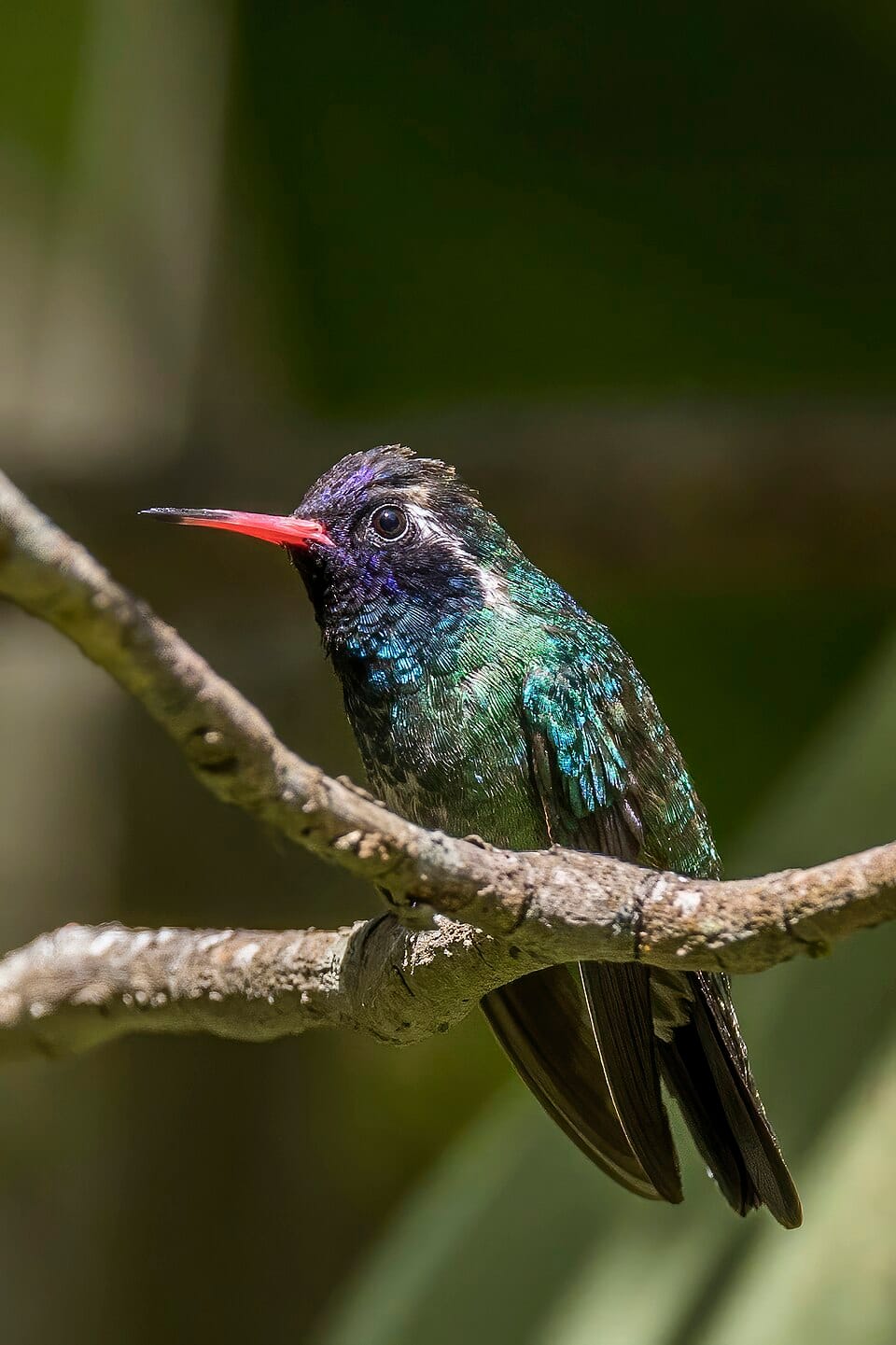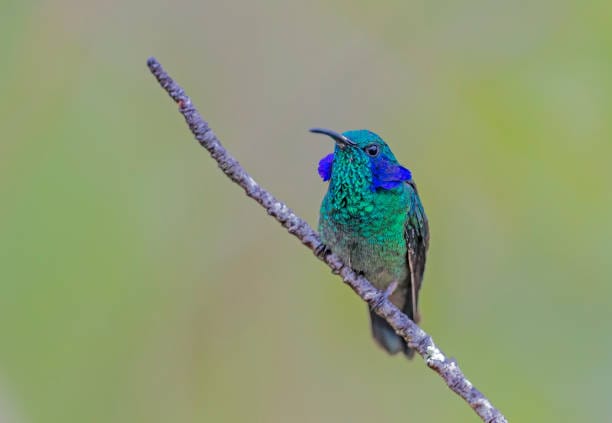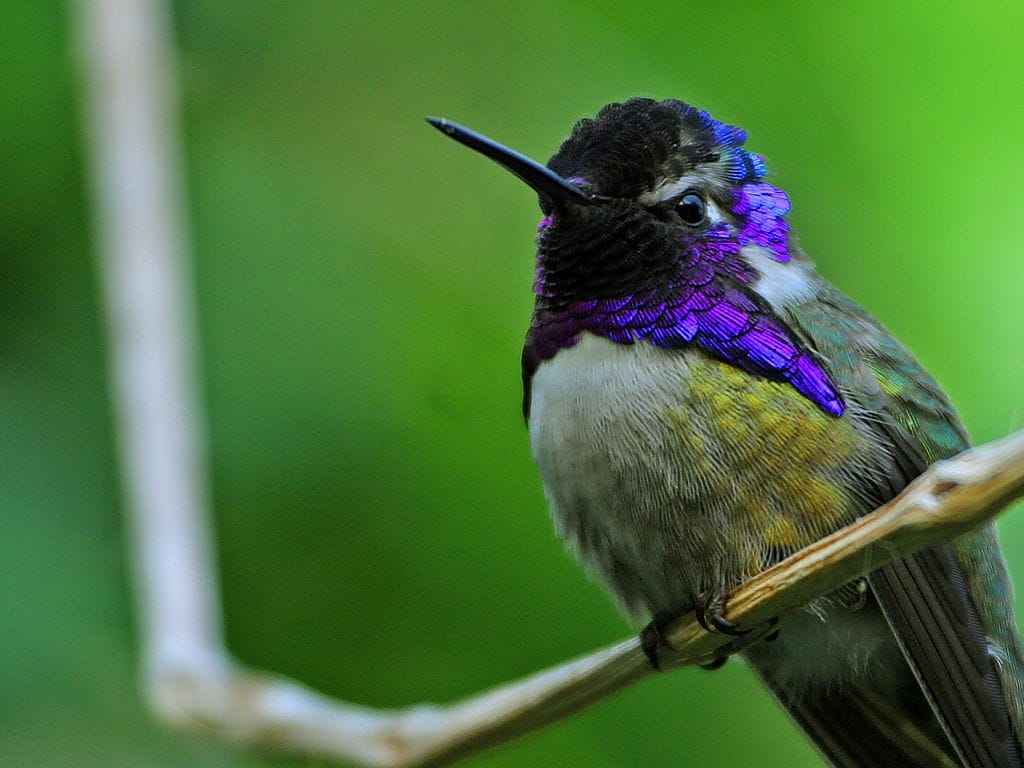Michigan, with its mix of forests, wetlands, and suburban gardens, is a delightful stopover for several hummingbird species. From the common Ruby-throated Hummingbird to rare vagrants like the Mexican Violetear, these tiny birds fascinate both casual observers and avid birdwatchers. Their rapid wingbeats, vibrant colors, and intricate behaviors make them a highlight of Michigan’s spring and summer months. This guide covers nine types of hummingbirds in Michigan, including identification tips, behavior, diet, habitat, and interactions with humans. Whether you’re setting up a backyard feeder or exploring local parks, learning about these birds enriches the experience and fosters appreciation for Michigan’s avian diversity.
1. Ruby-throated Hummingbird (Archilochus colubris)

Fun fact: The Ruby-throated Hummingbird is Michigan’s most common and iconic hummingbird, celebrated for its brilliant red throat and incredible migratory endurance.
Physical Characteristics & Identification Tips
Adult males have a ruby-red throat, green back, and white underparts. Females lack the red throat but display a slightly forked tail with white tips. They are 7–9 cm in length, weighing approximately 3 grams. Rapid hovering and darting flight help with identification.
Behavior and Nesting Habits
Males are fiercely territorial, defending nectar sources. Females build small, cup-shaped nests using plant down and spider silk on tree branches, camouflaging them carefully. Nests are primarily active from May to July.
Habitat and Range
They frequent deciduous forests, forest edges, gardens, and meadows. In Michigan, they are widespread, especially in the southern half of the state.
Diet
They feed mainly on nectar from tubular flowers and supplement with insects and spiders. Backyard feeders with sugar water attract them effectively.
Reproduction and Life Cycle
Females lay 1–3 eggs per clutch, incubating them for 12–14 days. Hatchlings fledge in 18–22 days. Typically, one brood is raised per season.
Fun Facts / Traits
Wing beats reach 50–80 per second, allowing them to hover and even fly backward. They migrate solo across the Gulf of Mexico each fall.
Human Interaction
Backyard birdwatchers commonly observe them at feeders, providing opportunities for study and enjoyment. Avoiding pesticides supports their insect diet.
2. Rufous Hummingbird (Selasphorus rufus)

Fun fact: The Rufous Hummingbird is a rare migrant visitor, notable for its fiery orange plumage and bold behavior.
Physical Characteristics & Identification Tips
Adult males have vivid orange-red backs and rufous underparts with a red throat; females are paler with green backs and rufous flanks. Measuring 7–9 cm, they are slightly smaller than Ruby-throated Hummingbirds. Look for energetic, zigzagging flight and vibrant colors.
Behavior and Nesting Habits
Rufous Hummingbirds are aggressive, often chasing other species from feeders. Breeding does not occur in Michigan, but females elsewhere construct tiny cup-shaped nests using plant fibers.
Habitat and Range
They prefer open areas, woodland edges, and gardens during migration. Sightings are occasional but increasing as migratory patterns shift.
Diet
Nectar from flowers and small insects provide energy, especially during long migration stops.
Reproduction and Life Cycle
Reproduction is uncommon in Michigan. In western breeding grounds, females lay 2 eggs per clutch, with fledglings leaving the nest in 18–22 days.
Fun Facts / Traits
Despite small size, Rufous Hummingbirds dominate other species at feeding sites due to their feisty nature.
Human Interaction
Birdwatchers treasure their visits. Providing native flowers and safe feeders increases sighting opportunities.
3. Anna’s Hummingbird (Calypte anna)

Fun fact: Anna’s Hummingbird occasionally reaches Michigan as a vagrant, dazzling observers with its iridescent emerald feathers.
Physical Characteristics & Identification Tips
Males show emerald green bodies with a rose-red throat and crown, while females are duller with green upperparts. They measure 9–10 cm in length. Identification relies on iridescent colors and distinctive hovering flight.
Behavior and Nesting Habits
Primarily territorial, they defend flower patches. Breeding does not occur in Michigan. Elsewhere, nests are cup-shaped, attached to thin branches, and made with plant fibers.
Habitat and Range
Found in gardens, forest edges, and parks during rare visits.
Diet
They feed on nectar and small insects to maintain energy for long flights.
Reproduction and Life Cycle
No breeding in Michigan; elsewhere, 2–3 eggs are laid per clutch.
Fun Facts / Traits
These hummingbirds are known for performing aerial courtship displays.
Human Interaction
Rare sightings excite local birdwatchers. Feeders with nectar can occasionally attract them.
4. White-eared Hummingbird (Basilinna leucotis)

Fun fact: Extremely rare in Michigan, often recorded only during accidental migrations.
Physical Characteristics & Identification Tips
Medium-sized hummingbird with green back, white ear patch, and grayish underparts. Males show faint red throat. Size is roughly 9 cm. Observers note the prominent ear patch for identification.
Behavior and Nesting Habits
Behavior in Michigan is unrecorded; in native ranges, they are territorial, and females build small, cup-shaped nests.
Habitat and Range
Native to Mexico, appearing in Michigan during rare migration events.
Diet
Feeds on nectar and small insects, typical for energy maintenance during migration.
Reproduction and Life Cycle
No breeding in Michigan.
Fun Facts / Traits
The striking white ear patch makes them easily distinguishable among vagrant hummingbirds.
Human Interaction
Observing this species in Michigan is considered a notable birding event.
5. Broad-billed Hummingbird (Cynanthus latirostris)

Fun fact: The Broad-billed Hummingbird is a rare visitor, recognized by its bright blue throat and long red bill.
Physical Characteristics & Identification Tips
Males display turquoise-blue throats and bright red bills; females are duller with green backs. Length is 9–10 cm. Key identification traits include bill color and throat patch.
Behavior and Nesting Habits
Behavior in Michigan is mostly unobserved; breeding occurs in southern Arizona and Mexico.
Habitat and Range
Native to southwestern U.S. and Mexico; Michigan records are vagrant sightings.
Diet
Feeds on nectar and small insects.
Reproduction and Life Cycle
No breeding occurs in Michigan.
Fun Facts / Traits
Known for long, curved bills adapted to specific flowers.
Human Interaction
Birders document each sighting carefully due to rarity.
6. Mexican Violetear (Colibri thalassinus)

Fun fact: The Mexican Violetear is one of Michigan’s rarest hummingbirds, usually appearing during unusual migratory movements.
Physical Characteristics & Identification Tips
Large hummingbird, 11–12 cm, bright green with violet ear patches. Easy to identify due to size and ear coloration.
Behavior and Nesting Habits
Behavior in Michigan is unrecorded; native populations are territorial.
Habitat and Range
Tropical forests in native range; Michigan sightings are accidental.
Diet
Nectar and insects.
Reproduction and Life Cycle
Not breeding in Michigan.
Fun Facts / Traits
Vivid violet ear patches are a signature identification feature.
Human Interaction
Each sighting excites local birding communities.
7. Black-chinned Hummingbird (Archilochus alexandri)

Fun fact: Rare in Michigan, this species is distinguished by its dark purple-black throat in males.
Physical Characteristics & Identification Tips
Males have black throats with iridescent purple edges; females are green-backed with gray underparts. Size is 7–9 cm.
Behavior and Nesting Habits
Behavior in Michigan is unknown; elsewhere, they are territorial and build cup-shaped nests.
Habitat and Range
Native to western U.S.; Michigan records are vagrant sightings.
Diet
Nectar and small insects.
Reproduction and Life Cycle
No breeding occurs in Michigan.
Fun Facts / Traits
Known for agile flight and sharp territorial defense.
Human Interaction
Birders cherish any sightings, documenting with photographs and notes.
8. Costa’s Hummingbird (Calypte costae)

Fun fact: Extremely rare vagrant in Michigan, identified by its elongated purple throat feathers in males.
Physical Characteristics & Identification Tips
Males show dark green back, violet throat, and extended crown plumes; females are more muted. Size is 9 cm.
Behavior and Nesting Habits
Behavior in Michigan is largely unknown; breeding occurs in southwestern U.S.
Habitat and Range
Native to arid regions; Michigan sightings are accidental.
Diet
Feeds on nectar and insects.
Reproduction and Life Cycle
No breeding occurs in Michigan.
Fun Facts / Traits
Displays long, thin throat feathers during courtship displays.
Human Interaction
Rare sightings are valuable for local bird records.
9. Berylline Hummingbird (Saucerottia beryllina)

Fun fact: Very rare in Michigan, this bird has a striking green body and is mostly observed as a vagrant.
Physical Characteristics & Identification Tips
Medium-sized, bright green plumage, slightly forked tail, males show subtle bluish throat. Length is 9–10 cm.
Behavior and Nesting Habits
Behavior in Michigan is unrecorded; breeding occurs in Mexico and Central America.
Habitat and Range
Native to tropical and subtropical regions; Michigan sightings are accidental.
Diet
Feeds on nectar and insects.
Reproduction and Life Cycle
No breeding occurs in Michigan.
Fun Facts / Traits
Rare sightings make it a prized observation for birders.
Human Interaction
Documented sightings contribute to citizen science and ornithological records.
Comparison Table of 9 Hummingbirds in Michigan
| No. | Species | Size (cm) | Male Plumage | Female Plumage | Breeding in Michigan | Frequency |
|---|---|---|---|---|---|---|
| 1 | Ruby-throated Hummingbird | 7–9 | Ruby-red throat, green back, white underparts | Green back, grayish-white underparts, white-tipped tail | Yes | Common |
| 2 | Rufous Hummingbird | 7–9 | Orange-red back, rufous underparts, red throat | Paler with green back and rufous flanks | No | Occasional |
| 3 | Anna’s Hummingbird | 9–10 | Emerald green body, rose-red throat and crown | Duller green upperparts, pale throat | No | Rare |
| 4 | White-eared Hummingbird | 9 | Green back, gray underparts, faint red throat, white ear patch | Similar to male but muted colors | No | Very Rare |
| 5 | Broad-billed Hummingbird | 9–10 | Turquoise-blue throat, bright red bill | Duller green back, lighter underparts | No | Very Rare |
| 6 | Mexican Violetear | 11–12 | Bright green with violet ear patches | Green with less pronounced violet patches | No | Extremely Rare |
| 7 | Black-chinned Hummingbird | 7–9 | Black throat with purple iridescent edge, green back | Green back, gray underparts | No | Very Rare |
| 8 | Costa’s Hummingbird | 9 | Dark green back, violet throat, extended crown plumes | Duller green, less pronounced violet throat | No | Extremely Rare |
| 9 | Berylline Hummingbird | 9–10 | Bright green plumage, subtle bluish throat, slightly forked tail | Similar but less vivid | No | Extremely Rare |
Conclusion
Michigan may not host a large variety of hummingbirds, but the nine species recorded, from the common Ruby-throated Hummingbird to rare vagrants like Mexican Violetear and Berylline Hummingbird, offer a fascinating glimpse into these remarkable creatures. Backyard feeders, native flowers, and safe observation areas can increase chances of sightings, helping both the birds and enthusiasts enjoy the magical presence of hummingbirds in Michigan.
Frequently Asked Questions about Hummingbirds in Michigan
- What types of hummingbirds are found in Michigan?Michigan hosts several species, including Ruby-throated Hummingbirds, Rufous Hummingbirds, Anna’s Hummingbirds, and occasional rare vagrants like Mexican Violetear.
- When is the best time to see hummingbirds in Michigan?The peak season is late spring through early fall, particularly from May to September when migration occurs.
- Do hummingbirds breed in Michigan?Yes, Ruby-throated Hummingbirds are the only species that regularly breed in Michigan.
- How can I attract hummingbirds to my Michigan backyard?Plant native flowers, provide sugar-water feeders, and avoid pesticides to create a welcoming habitat.
- What flowers attract hummingbirds in Michigan?Tubular flowers like bee balm, trumpet vine, columbine, and cardinal flower are popular among Michigan hummingbirds.
- Are hummingbirds common in Michigan gardens?Yes, especially in areas with abundant nectar sources and safe feeding stations.
- What do hummingbirds eat in Michigan?Their diet consists mainly of nectar from flowers, supplemented with small insects and spiders for protein.
- How many hummingbird species migrate through Michigan?Several species pass through, including Rufous, Calliope, Anna’s, and vagrant species like Mexican Violetear.
- Do hummingbirds hibernate in Michigan?No, hummingbirds migrate south to warmer areas during the winter months.
- How fast do hummingbirds fly in Michigan?They can hover in place and dart at speeds up to 30 mph, making them fascinating to observe.
- Where do Ruby-throated Hummingbirds nest in Michigan?They build tiny cup-shaped nests on branches in deciduous trees, shrubs, or gardens.
- Are hummingbird feeders safe in Michigan?Yes, when cleaned regularly with a sugar-water solution, feeders are safe and encourage repeat visits.
- Do all hummingbirds migrate through Michigan?No, only certain species migrate through; others are rare vagrants or accidental visitors.
- What is the smallest hummingbird found in Michigan?The Calliope Hummingbird, at just 7–8 cm long, is the smallest long-distance migrant seen in Michigan.
- Can I see Mexican Violetear in Michigan?It is extremely rare but has been recorded occasionally during vagrant migration events.
- Do Michigan hummingbirds visit urban areas?Yes, hummingbirds often visit gardens, parks, and urban backyards with feeders and flowering plants.
- How long do hummingbirds live in Michigan?Most live 3–5 years, though some may survive up to a decade with favorable conditions.
- Are there hummingbird festivals in Michigan?Several local birding organizations host seasonal events to celebrate migration and encourage backyard observation.
- How far do hummingbirds migrate through Michigan?Ruby-throated Hummingbirds migrate thousands of miles from Central America, passing through Michigan on their route.
- What colors do Michigan hummingbirds display?Colors range from ruby-red throats in males to green backs, orange rufous shades, and iridescent violet patches in vagrants.
- How can I identify hummingbirds in Michigan?Look for size, throat color, wingbeat patterns, and flight behavior to distinguish species like Ruby-throated or Rufous Hummingbirds.
- Do Michigan hummingbirds eat insects?Yes, they consume small insects and spiders to supplement their high-energy diet from nectar.
- When do hummingbirds leave Michigan for winter?Most migrate south around late August to early October, depending on food availability and weather.
- Can hummingbirds be endangered in Michigan?Currently, most species in Michigan are not endangered, though habitat loss and climate change may pose future risks.
- Do hummingbirds fight in Michigan?Yes, especially males; they defend nectar sources aggressively, often chasing away other birds.
- How high do hummingbirds fly over Michigan?They typically stay near flowering plants but can fly several meters high during migration or territorial disputes.
- Are there hummingbirds in northern Michigan?Yes, though sightings are less frequent than in southern regions, especially during migration.
- Do hummingbirds return to the same Michigan gardens each year?Many do, especially if consistent nectar sources and feeders are maintained.
- What time of day are Michigan hummingbirds most active?They feed throughout daylight hours but are most active during early morning and late afternoon.
- Can I photograph hummingbirds in Michigan?Yes, with patience and fast shutter speeds, bird photographers often capture these fast-moving birds.
- Are there rare hummingbirds in Michigan?Yes, species like Mexican Violetear, Berylline Hummingbird, and Allen’s Hummingbird appear as accidental visitors.
- Do Michigan hummingbirds prefer native or exotic plants?They are attracted to both, but native tubular flowers provide the best nectar and are preferred for long-term sustainability.
- How can schools in Michigan educate about hummingbirds?By creating butterfly and hummingbird gardens, students can learn about migration, diet, and ecology firsthand.
- Do Michigan hummingbirds interact with other bird species?Yes, they compete for nectar and may chase other small birds, while generally avoiding larger birds.
